「再基地:當實驗成為態度」的展出空間涵蓋了臺灣當代文化實驗場(C-LAB)中的五棟建築:聯合餐廳、通信分隊、圖書館、新辦公大樓、中正堂與戰情大樓,是C-LAB啟動以來,整體規模最大的一次展覽活動。這處原為空軍總司令部的園區不同於一般展場的空間分布,各建物之間距離遠,策展團隊為此發展出展覽作品以外的文字系統,於作品所在的建築外側,甚至在園區對外道路圍牆掛上與各個藝術家作品內容相關的關鍵語句,用以呼應作品與空間的關係。
行經C-LAB位在建國南路上的入口,韓國藝術家團體「張英海重工業」的作品透過戶外巨型LED字幕牆吸引往來者的注意。這個成立於1999年的雙人團體,早期作品多為網路藝術形式,後期則以一貫的文字影像搭配音樂呈現。過往張英海重工業的作品都是於室內呈現,而此次於聯合餐廳展演空間廣場展出的《100種幸運》,是首次嘗試的戶外作品,藉由100個幽默又帶有諷刺意味的短句,直接點現藝術環境的眾相,在引人莞爾之餘進一步探討藝術家在當代的身分角色。
走入聯合餐廳展演空間二樓,首先看到的是陳慧嶠裝置作品《床外的藍天》。長期以來,陳慧嶠擅以現成物的組構或對峙進行議題探討,此次作品除了從空總基地歷史延伸,另一個出發點則是一戰結束100週年(2018年11月11日)。《床外的藍天》以16張布滿針與彩線的軍床構成,並以星象中由許多軍市星組成的大犬座作為地面定位,在這個經常指向造夢、愛慾、生死與休憩想像的物件中,進一步思考軍事與科技發展下,人類歷史中含藏的陰暗角落,以及從作品與空間關係中所衍生的想像。位於陳慧嶠作品後方,吳其育的三頻道錄像《亞洲大氣》充分利用了該空間的畸零造型,他將空間想像為一VR裝置觀看體驗,而觀眾所在之處則像站立在左右腦之中。吳其育的近期作品思考影像投映對空間的造形能力,以及藉由非人視點觀看人類歷史。這件以無人空拍機的視角作為敘事人稱的作品,靈感來自他對空總撤出後,基地多處空間仍留下的飛航地圖,並進一步探問其在被不同國家、目的所畫出的空域範圍下,人們如何對天空進行規範和管制。
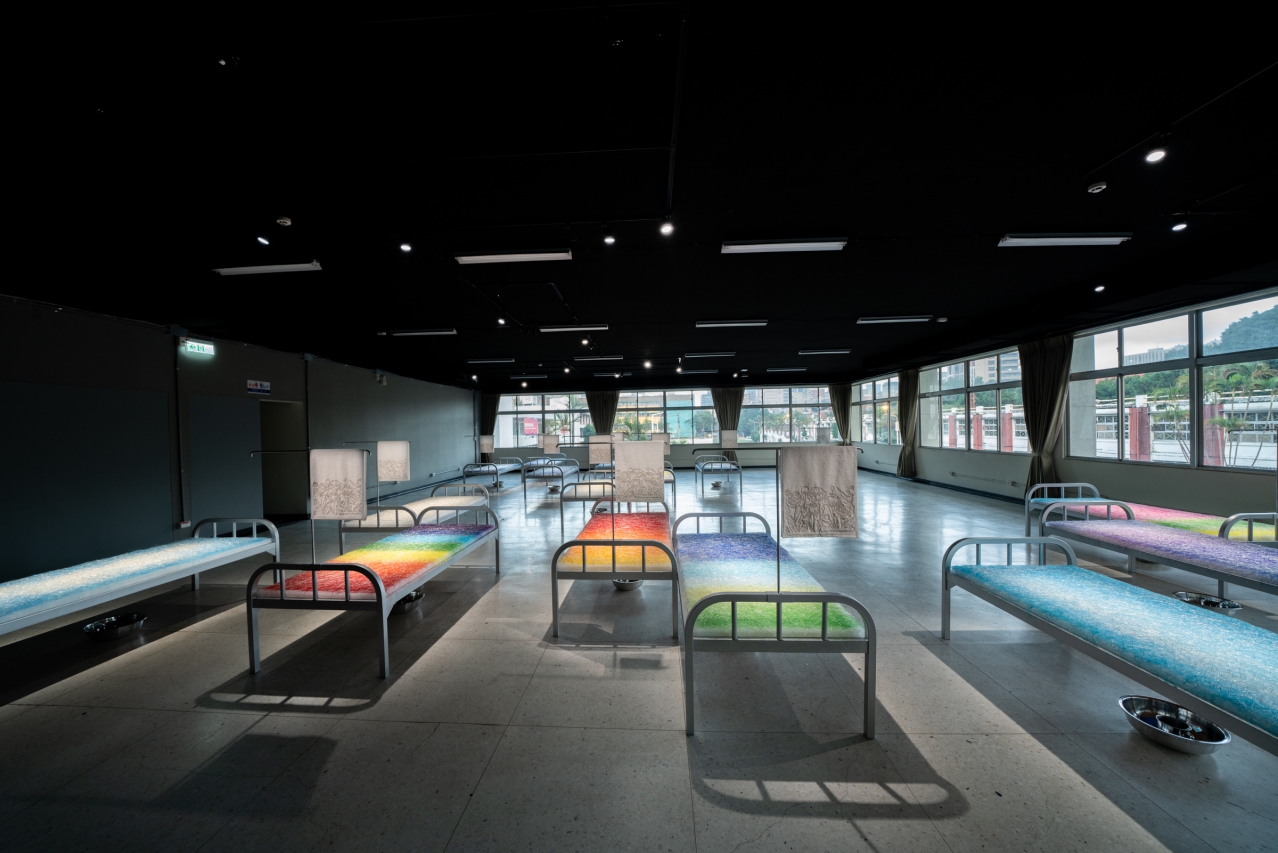 陳慧嶠裝置作品《床外的藍天》。圖/臺灣當代文化實驗場提供
陳慧嶠裝置作品《床外的藍天》。圖/臺灣當代文化實驗場提供
長年思考視覺議題的高重黎,這次藉由三組作品討論影像、客體與主體之間相互觀看和映射的關係。位於通信分隊入口弧形空間的《Narcissus with Echo》一如作品名稱所示,這座可360度旋轉的動力裝置不斷藉由多鏡面與攝影機對空間(包括觀眾身影)進行擷取與放映。而由15台類比電視及攝影機構成的電視牆裝置《迷宮中的誰》,其畫面則來自鏡頭對觀眾面容即時拍攝、延遲播放的影像,觀眾在此觀看作品,但同時也被攝影之眼所注視。從影像的「反射」與「透射」概念出發,高重黎藉由實物投影機原理所做的「物象書」系列〈轉形正義〉、〈卡賓槍手〉、〈瘋狂的一頁〉,除了持續藝術家對影像本質的探問、藉由援引高達(Jean-Luc GODARD)的電影作品《卡賓槍手》畫面,與收集自戰爭期間的一卡皮箱物件回應歷史外,也進一步帶出創作者對「沒有歷史的元影像」的討論與實驗。
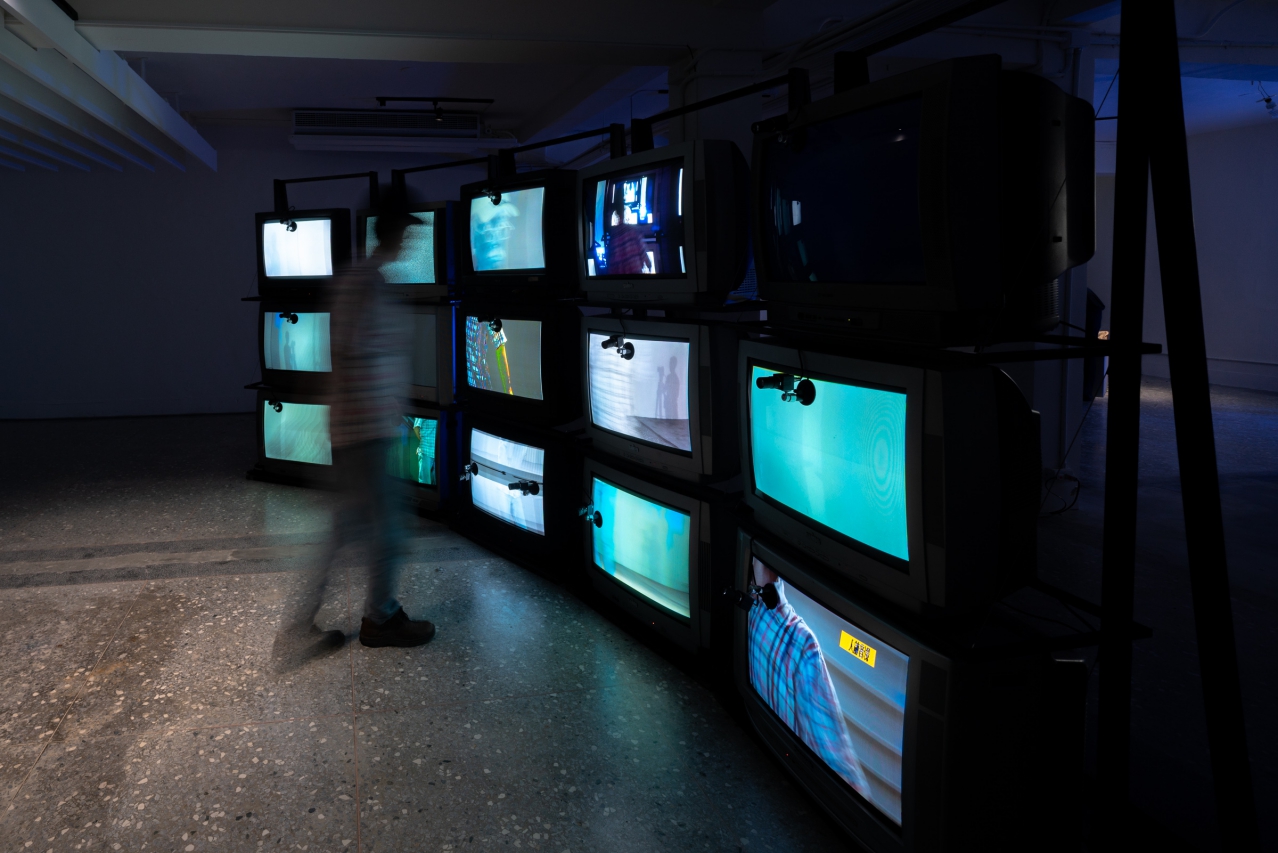 高重黎《迷宮中的誰》。圖/臺灣當代文化實驗場提供
高重黎《迷宮中的誰》。圖/臺灣當代文化實驗場提供
繼2018年9月在奧地利林茲電子藝術節的《Sleep 48》計畫,位於圖書館展演空間一樓,以多項活動組構、為期79天的《Sleep 79》,是藝術家鄭淑麗與馬修.富勒(Matthew FULLER)對睡眠議題的再次延伸。25張人力車造型的行動睡眠車開放讓觀眾休憩,在此空間中每週都有不同活動發生(唸書睡宿、與蚊共眠等)。主展場後方空間則包含一座收集睡眠檔案、相關書籍的小型圖書館,以及藝術家山崗希子、張英海重工業、馬修.富勒的睡眠相關作品展示。觀眾也可在現場啜飲與本計畫合作,由林芝宇(雜草稍慢)收集自C-LAB周圍可食用雜草所煮的茶品「肅靜」、「喧囂」,以及由禾餘麥酒特為此次計畫釀造的「乎哇睏好睡啤酒」(第一版「好睡啤酒」是由奧地利釀酒廠Thor Bräu與Stadtwerkstatt文化中心為《Sleep 48》活動所製作,酒中加入具有助眠效果帶有苦味的植物刺五加)。
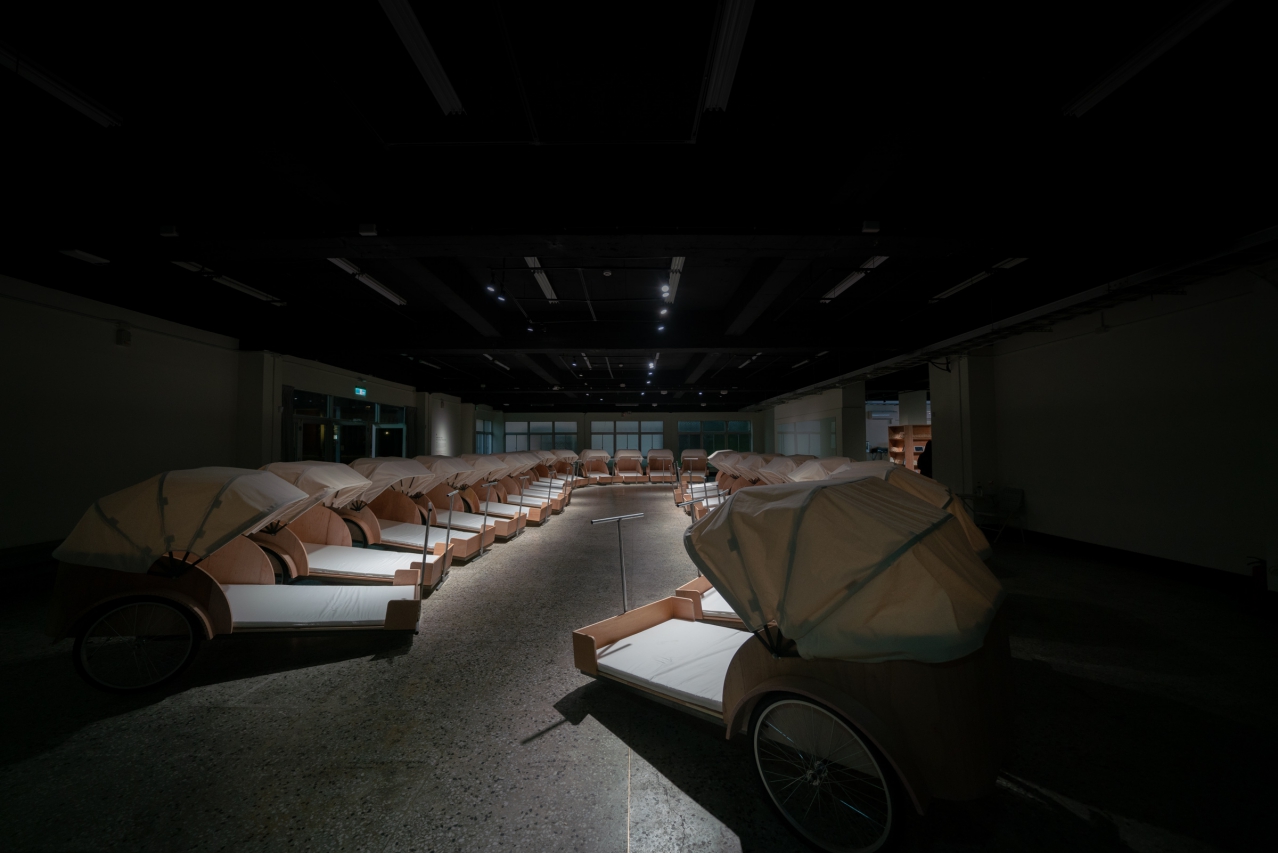 鄭淑麗與馬修.富勒(Matthew FULLER)《Sleep 79》。圖/臺灣當代文化實驗場提供
鄭淑麗與馬修.富勒(Matthew FULLER)《Sleep 79》。圖/臺灣當代文化實驗場提供
隨階梯走入圖書館展演空間二樓,首先看到張英海重工業的第二件作品《命運》。這件作品是兩位藝術家數月前受展覽邀請來臺,於城市訪查中發現的靈感,他們將在臺灣寺廟中觀察到的算命文化、擲筊求籤的習俗轉換為文字,探問人面對未知的茫然甚或恐懼時,渴望被指點迷津的想法,藉此隱喻人們對人生、環境的態度,以及是否將生命中的壓力想像為某種不可抗拒的命運與力量。二樓另一側空間,展出的是周曼農結合劇本、表演與空間裝置的複合性創作《少女機器》。作品靈感來自日本的「少女」研究,周曼農以此概念回看C-LAB過去作為軍事、政治甚至歷經工業、統治等階段的功能轉換,並以此對應這處空間原本相對陽剛與固化的場域想像。《少女機器》於展覽期間共有四場現場演出,場地樣貌也在活動中陸續變動。
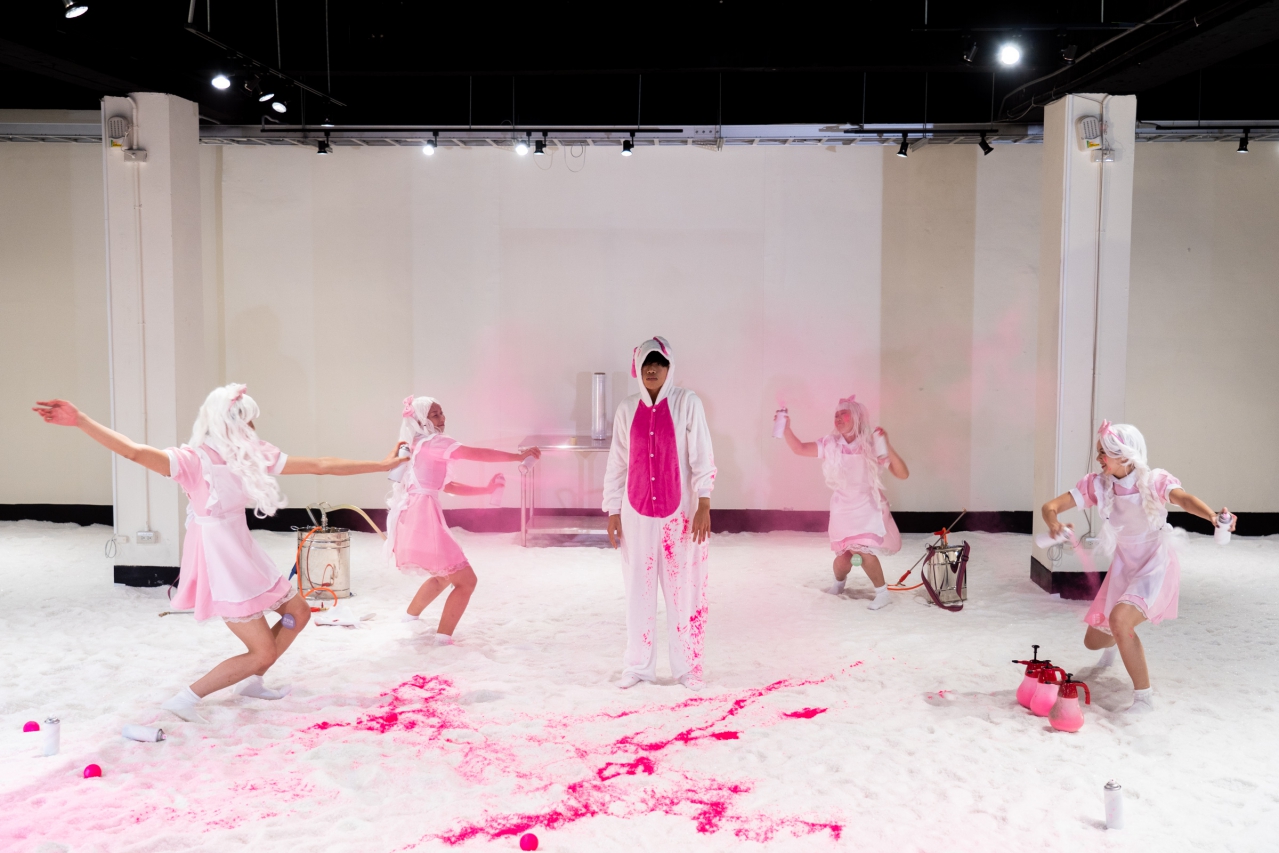 周曼農《少女機器》的首場演出「序」。圖/臺灣當代文化實驗場提供
周曼農《少女機器》的首場演出「序」。圖/臺灣當代文化實驗場提供
從新辦公大樓建築物前延伸出來的黑色盒狀空間,是詩人夏宇作品《只有雨讓城市傾斜》。這件作品的基底來自2016年的詩集《第一人稱》,在這本帶有電影概念的出版品中,夏宇以500多張旅行拍攝的壞照片,與300多行音樂性強烈的句子構成如影院黑盒般的閱讀感。而此次《只有雨讓城市傾斜》繼續延伸這樣的概念,加入新的影像,並且以新的詩作、400多行的〈反音樂性19首〉為文本,文字跑馬燈與影像的關係在閱讀過程中不斷變化,而裝置中隔開觀眾與影像詩句間的雨屏,既拉開了兩者的距離,同時也製造了與身體相關的另一種感官閱讀經驗。
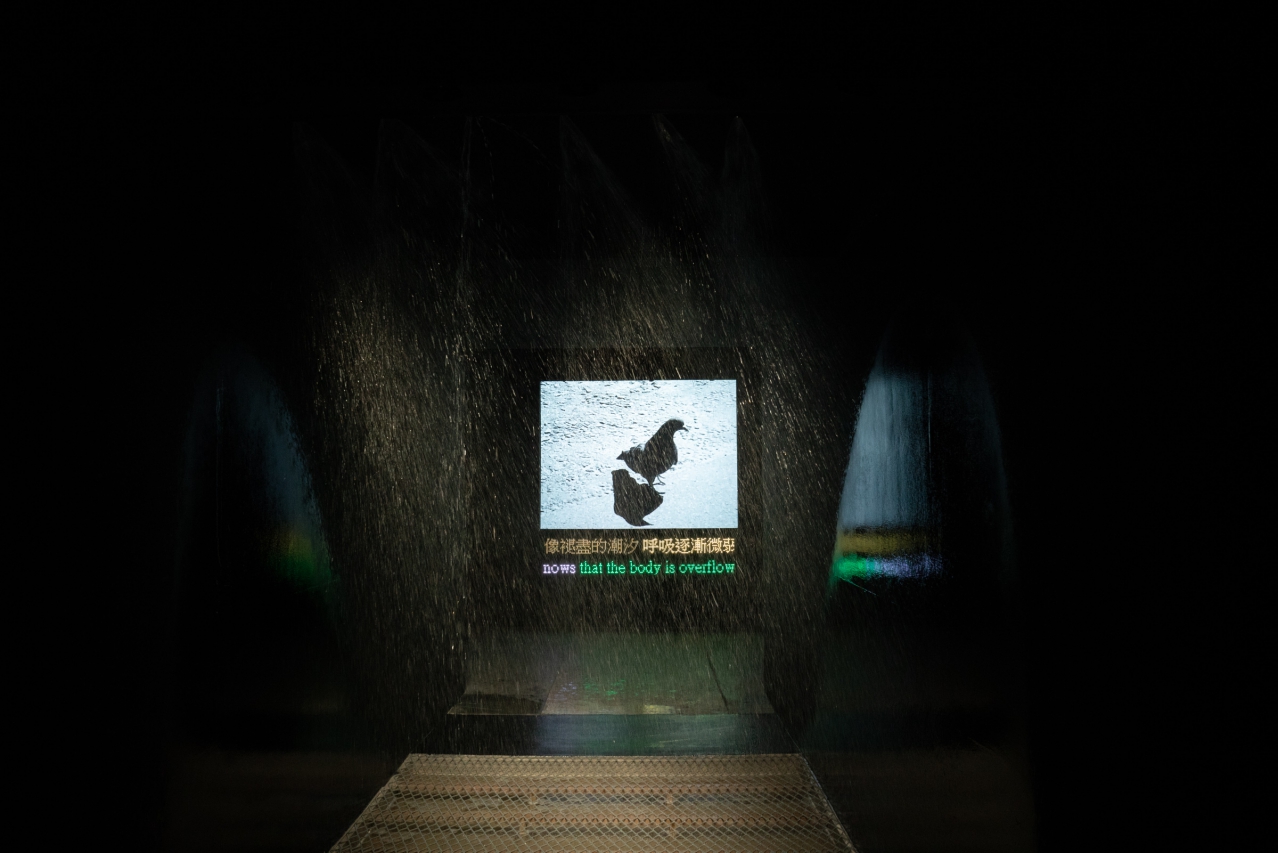 夏宇《只有雨讓城市傾斜》。圖/臺灣當代文化實驗場提供
夏宇《只有雨讓城市傾斜》。圖/臺灣當代文化實驗場提供
「再基地」展中另一件表演作品,是明日和合製作所的《林愛國招募計畫》,這件作品雖標示於園區內、原為空總大禮堂的中正堂,但其實作品是隨參與演出者的身體而不斷移動。《林愛國招募計畫》的構想在於回應空總空間,思考在象徵國家形象的儀隊演出中,對性別的想像是什麼;在陽剛形象的軍儀隊樣貌下,又是否排除了某些人的行為。該計畫透過招募外在形象較為陰柔的生理男性,每週末於現場進行儀隊操演、公開排練,以及帶有諷刺意味、討論生理男性如何更man的相關課程,並在2019年元旦上午與總統府前廣場同步,於C-LAB展區進行升旗典禮暨儀隊訓練成果演出。
走入中正堂內,原空總禮堂空間升起了大型銀幕, 肯.瑞納多(Ken RINALDO)的3D影像作品《不停歇的戰爭列車》中載滿軍事武器的貨運火車正緩慢穿越影像中的平民城鎮。肯.瑞納多早期的作品多在探討人跟機械、自然、環境的關係,此次的全新製作來自他對美國軍事支出的疑慮與憂心。美國總統川普(Donald TRUMP)上任後,宣布將於2020年完成太空軍的籌建,這個新的獨立軍種在全球化的國際局勢中造成緊張氛圍,而美國對軍事國防預算的支出甚至是鄰近12個國家加總的12倍。肯.瑞納多認為,這種以防禦為名的軍需支出,直接擠壓了更重要的人道救援或教育、全球暖化等問題的相關預算。在這個看似平和的日常中,其實戰爭從未停止。
來到位於C-LAB園區中心位置的戰情大樓,與肯.瑞納多遙遙呼應的作品是位於二樓、在展出時間每個整點與半點開放入場的《空域》。這件由陳志建以AR擴增實境技術製作的作品,座落原空總的空軍總司令辦公室內,以繚繞於空間地面的人造煙霧暗喻雲景與天空,觀眾則透過AR裝置看見像幽靈般在此飛行虛構物體。而在這臺灣空防最高指揮中心的廢墟空間裡,至今仍可看見過去保留下來的牆面文件。在收集資料期間,陳志建發現作為一般民眾,幾乎無法得知這個空間原本的內部歷史,最容易取得的材料是來自媒體塑造的軍事形象,如閱兵、軍需採購內容等,在《空域》中他除了以3D再現近期臺灣陸軍航空特戰指揮部601旅的閱兵展示畫面,也藉由臺灣希望購入史上最貴戰機F35時的媒體討論,重新思考軍權跟自然之間的定位問題。
而在戰情大樓一樓兩側房間內,鄧堯鴻的《繭影》以多件被遺忘於日常的廢棄物,以及一隻彷彿正穿躍於空間內的巨大鼠屍模型構成。鄧堯鴻的作品都與時間的醞釀相關,一件雕塑往往需要耗時多年的發展才能趨近他心中的完成狀態。他描述自己與這些收集而來的廢棄、剩餘之物的持續對話,就像日常素描般不斷地記錄。五年前搬家時,鄧堯鴻發現藏在角落多年、已風化如落葉一般的鼠屍,在醞釀沉澱後以兩年時間完成這件大型雕塑,他以這些遺落在地面、縫隙中布滿塵絮的遺忘物對應翱翔領空的基地歷史,也指向不可見的遺憾或被擱置的記憶如何在此被重構。
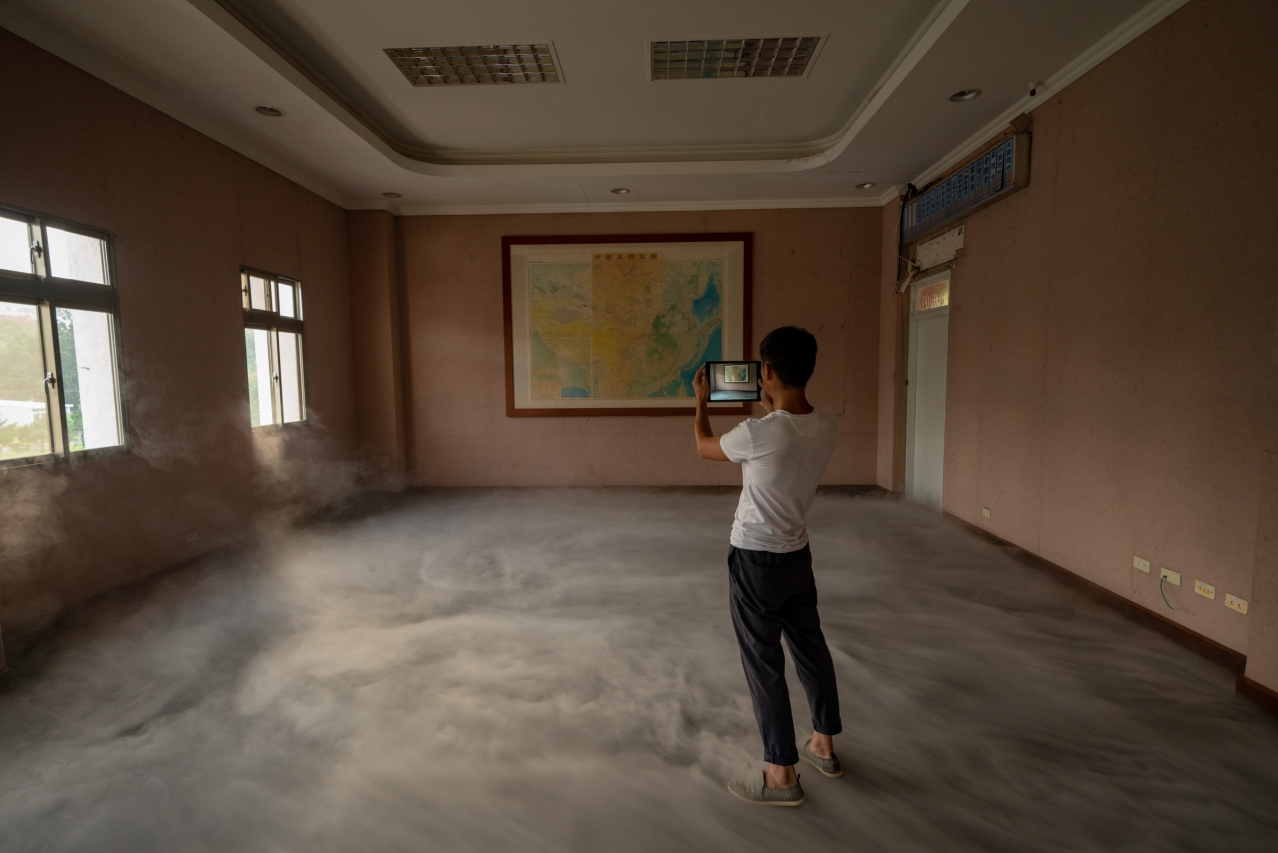 陳志建《空域》。圖/臺灣當代文化實驗場提供
陳志建《空域》。圖/臺灣當代文化實驗場提供